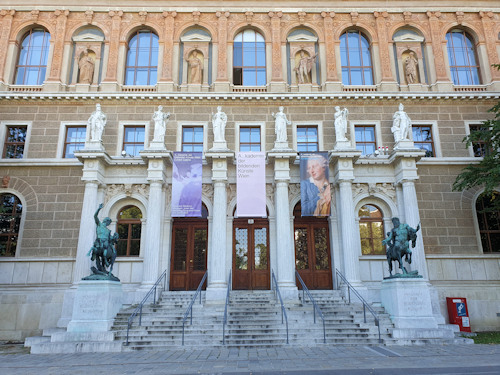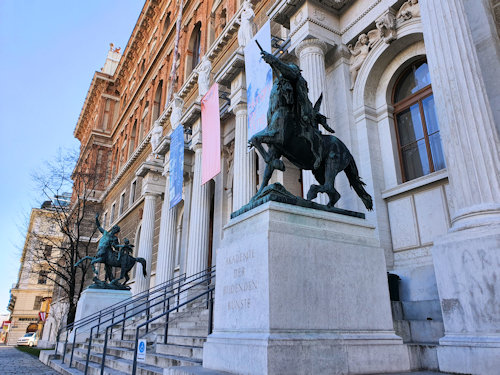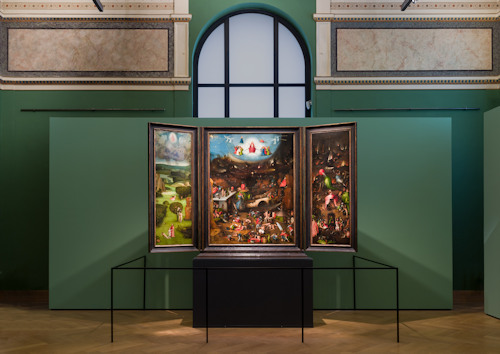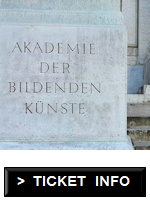You might expect one of Austria’s finest art collections to reside in some grand museum. Instead, the paintings of such artists as Rembrandt, Titian, Klimt, Rubens, Bruegel, Dürer, and van Dyck find a home in a Viennese university: the Academy of Fine Arts Vienna.
- Collection highlights on public view in special exhibitions
- Art collection includes modern and contemporary pieces, too
- Home to Hieronymus Bosch’s Last Judgement
- What special exhibitions are on?
- See also:
Academy of Fine Arts Vienna

(Enter for art, education, and inspiration)
The academy (which holds university status) looks back on a long history that began toward the end of the 1600s.
Former students and teachers include such names as Ferdinand Georg Waldmüller, Otto Wagner (who gets a memorial column on one side of the building), Egon Schiele, Friedensreich Hundertwasser, Ernst Fuchs, and Gottfried Helnwein. And a certain Adolf Hitler was famously denied a place…twice.
The institution’s current home on Schillerplatz went up in the 1870s to designs by Theophil Hansen, the architect behind Austria’s parliament building, the Alte Börse, and the Musikverein. You might recognise it from a significant role in the movie The Woman in Gold.
The building looks rather pristine, despite its venerable age. We can thank a major renovation project for that; the university only moved back there in 2021.
Acquisitions, donations and the efforts of the academy’s own students and staff across more than three centuries have, inevitably, resulted in a significant in-house art collection.

(Classical statues flank the entrance)
Here we’re not talking about the submissions of Viennese teenagers applying for a degree place: this is a collection that stretches from medieval masterpieces through to the present.
Think Albrecht Dürer. Or Gustav Klimt. Bosch and Bruegel. Van Dyck and von Alt. Hundertwasser and Schiele. Rembrandt and Rubens. Titian and Boticelli.
Fortunately for us, the academy’s galleries offer a public home to highlights from the collection.
What you see depends on when you go, and your visit may even fall into a gap when the Gemäldegalerie closes between special exhibitions. So check below (or wider exhibition listings) for the latest schedule.
These exhibitions typically feature a mix of collection highlights in dialogue with one or more contemporary works.

(Hieronymus Bosch, Last Judgement Triptych, c. 1490 –1505; image © Paintings Gallery of the Academy of Fine Arts Vienna; photo by Iris Ranzinger)
Incidentally, the academy may have other exhibition spaces open at the same time so watch for those.
One item that looks likely to appear in every main exhibition is what might be the collection’s greatest treasure: the Last Judgement Triptych by Hieronymus Bosch, produced in the first decade of the 16th century.
Tickets, exhibitions & tips
At the time of writing, you buy your tickets for the paintings gallery on site. Last time I checked (early 2025), a standard adult ticket cost €12.
Special exhibitions
The current schedule:
- Wild Apollo’s Arrows. Klopstock Cult & Ossian Fever (March 7th to May 25th, 2025)
- Considering the Collection (March 7th to May 25th, 2025): more in-house highlights
Some extra tips:
- The front entrance of the academy looks out over a park with a large monument to the German literary giant Friedrich Schiller
- Once you enter the building, go on through and turn right down the corridor, then up two sets of stairs (or take the lift) to Floor 1 (where the exhibitions take place)
- Enjoy the interior decoration as you go. For example, look through the glass doors opposite the entrance to see the Aula hall with its huge ceiling paintings by the German artist Anselm Feuerbach (the hall also features in The Woman in Gold)
If you’re most interested in paintings by Old Masters, then be sure to also visit the Kunsthistorisches Museum. When you leave the academy, simply turn left and walk to the end of Niebelungengasse.
That route also takes you past Palais Eschenbach, a lovely building from 1872 that also hosts classical concerts tailored to the needs of visitors.
How to get to the collection
Subway: Karlsplatz station is very close (on the U1, U2 and U4 subway lines). Just be sure to take a west exit from the underground complex.
Tram/bus: The trams that skirt the edge of the old town stop nearby, too. Take the 1, 2, D or 71 to either Burgring or Oper/Karlsplatz.
Address: Schillerplatz 3, 1010 Vienna | Website
